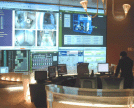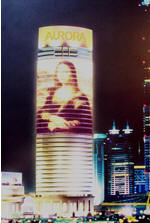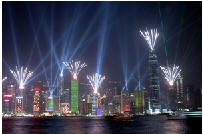June 2006
![]()
AutomatedBuildings.com
[an error occurred while processing this directive]
(Click Message to Learn More)
June 2006 |
[an error occurred while processing this directive] |
|
Building Automation - Realcomm Asia Tour |
Darlene Pope, Realcomm |
I just recently returned from two weeks in Asia on the Realcomm NextGen Best Practices Tour, visiting some of the most technologically advanced buildings in the world! It was an amazing trip in terms of witnessing how technology is incorporated into the design, development, and operation of their buildings. Here is a brief overview of the trip and a snapshot of what we saw...
 The
overwhelming theme of development in Asia was client "comfort and convenience."
Technologies were embedded into the base building design to ensure that the
occupants of the property, whether commercial or residential, were able to
receive the maximum tenant experience with the most efficient use of their time
and space. For example, at one facility, we witnessed web-based controls
for each person's office lighting, air handling, and even window blinds,
enabling each tenant to control their individual office environment with the
click of their mouse. At another property, the after-hours security and
HVAC system could be controlled by the occupant's IP phone - and automatically
billed accordingly.
The
overwhelming theme of development in Asia was client "comfort and convenience."
Technologies were embedded into the base building design to ensure that the
occupants of the property, whether commercial or residential, were able to
receive the maximum tenant experience with the most efficient use of their time
and space. For example, at one facility, we witnessed web-based controls
for each person's office lighting, air handling, and even window blinds,
enabling each tenant to control their individual office environment with the
click of their mouse. At another property, the after-hours security and
HVAC system could be controlled by the occupant's IP phone - and automatically
billed accordingly.
 Building
automation was evident in every building we toured. Building operations offices
were state-of-the-art command centers with dozens of high-resolution wide-screen
displays and monitoring systems, all reporting in real-time through web-based
software programs. Elevators, chillers, water, electricity, lighting, and
security were all tied into the building IP network - yes, I said the building
IP network - to allow most efficient monitoring and maintenance of all building
systems. The use of computers to monitor and control these properties meant that
building engineers were more likely to have a computer science degree than a
mechanical engineering background.
Building
automation was evident in every building we toured. Building operations offices
were state-of-the-art command centers with dozens of high-resolution wide-screen
displays and monitoring systems, all reporting in real-time through web-based
software programs. Elevators, chillers, water, electricity, lighting, and
security were all tied into the building IP network - yes, I said the building
IP network - to allow most efficient monitoring and maintenance of all building
systems. The use of computers to monitor and control these properties meant that
building engineers were more likely to have a computer science degree than a
mechanical engineering background.
Energy efficiency was visible everywhere. From card-key master control switches in our hotel rooms (when you left the room and took your card key, all the lights went out), to motion-sensor controlled escalators, lighting, faucets, toilets - everything was designed with the most efficient use of energy. One of the most advanced examples of efficiency in building systems were elevators that had no buttons on the inside! Floor selection was done on a key pad in the elevator lobby (not in the elevator itself), and an LCD screen immediately showed which elevator cab was dispatched to the call -- enabling the rider to be ready to board as soon as the cab arrived and facilitating the most efficient use of the elevators.
 Digital
signage was everywhere. No plastic directory strips! Tenant directories
were all interactive touch screen displays that provided much more than
tenant listings - maps of the area, information about vendors or retail space in
the building, nearby restaurants, local weather and traffic, advertising, and
more. Every lobby lit up with plasma screens streaming local or national
news or weather - it was truly refreshing! One of the most fascinating
examples of digital signage was the Aurora building in Shanghai, where at night,
a full half of the fašade turns into the largest digital sign in the world! The
sign is used to display advertisements, announcements, or even art (when we were
there, it was the Mona Lisa!).
Digital
signage was everywhere. No plastic directory strips! Tenant directories
were all interactive touch screen displays that provided much more than
tenant listings - maps of the area, information about vendors or retail space in
the building, nearby restaurants, local weather and traffic, advertising, and
more. Every lobby lit up with plasma screens streaming local or national
news or weather - it was truly refreshing! One of the most fascinating
examples of digital signage was the Aurora building in Shanghai, where at night,
a full half of the fašade turns into the largest digital sign in the world! The
sign is used to display advertisements, announcements, or even art (when we were
there, it was the Mona Lisa!).
And of course, wireless. Wireless, wireless, everywhere. Every building we toured had multiple cellular carriers and WiFi antennas on every floor - including the penthouse, elevator lobbies, underground levels, and parking garages. Wireless communications and commerce are so embedded into the Asian culture, that the thought of not having wireless coverage in buildings is almost unheard of. They literally laughed when I asked if they had wireless coverage in one of the buildings - the response was "of course." It won't be long before cell phones or other wireless devices will be used for building access control, security, payment of parking fees, and more. So for those of you who have seen the new Mission Impossible III (we toured the buildings in Shanghai where the movie was filmed), don't believe for a minute the scene where Tom Cruise can't pick up a cell phone signal!
"We were all surprised that we had five bars in the elevators -- not to mention the garage and the penthouse," reported Kelley Carr, VP of Cellular Specialties. "It was refreshing to see so many cellular antennas in the properties we toured."
Last, but certainly not least, paperless parking and automated garages. If I can use my Toll Pass to drive from Virginia to Boston without having to punch a ticket or pull out a single dollar bill - why is it that our buildings still require paper tickets and paper payments? Many of the parking garages in Asia have a "toll pass" system that allows for wireless scanning and automatic billing for parking fees. Several of the properties had installed motion sensors in each space to clearly show with a red or green light which spaces were available and which were full. One of the more advanced properties even had a scanner that read the license plate numbers to allow VIPs to park on a private level and access a secure elevator lift.
"What impressed me the most was the incorporation of all these technologies in each project," said Tommy Russo, CIO at Akridge. "Here in the US, you might find a building that has installed one or two of these innovative ideas -- but none that have adopted all of them across the board, as was very common in Asia. We're already looking at adding some of these features into our buildings."
 The
grand finale of our trip was a spectacular laser light show comprised of dozens
of trophy buildings that make up the skyline of Hong Kong. The buildings were
literally networked together to create an amazing visual display of aerial
lighting and colored lighting on the building facades that was all choreographed
to music.
The
grand finale of our trip was a spectacular laser light show comprised of dozens
of trophy buildings that make up the skyline of Hong Kong. The buildings were
literally networked together to create an amazing visual display of aerial
lighting and colored lighting on the building facades that was all choreographed
to music.
So, having returned from the Realcomm Asia Tour, I am both inspired and discouraged. Inspired by the innovation and implementation of technology we saw literally everywhere (waitresses with wireless notepads and even a cellular antenna in an underground nightclub) - but discouraged by the apparent lack of adoption of similar technologies into our properties in the US. Is it lack of knowledge, lack of education, lack of competitive motivation -- or just lack of interest? Any way you look at it - we're getting our butts kicked.
Dubai NextGen Best Practices Tour November 3-9, 2006 http://www.realcomm.com/dubai.htm
[an error occurred while processing this directive]
[Click Banner To Learn More]
[Home Page] [The Automator] [About] [Subscribe ] [Contact Us]